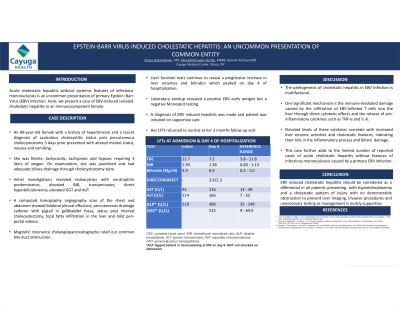Monday Poster Session
Category: Liver
P3154 - A Case of Epstein-Barr Virus-Induced Cholestatic Hepatitis: An Uncommon Presentation of Common Entity
Monday, October 28, 2024
10:30 AM - 4:00 PM ET
Location: Exhibit Hall E

Has Audio
- EO
Etiosa Osemwinyen, MD
Cayuga Medical Center
Ithaca, NY
Presenting Author(s)
Etiosa Osemwinyen, MD, Ekenedilichukwu Ilechie, MBBS, Sameer Acharya, MD
Cayuga Medical Center, Ithaca, NY
Introduction: Acute cholestatic hepatitis without systemic features of infectious mononucleosis is an uncommon presentation of primary Epstein–Barr Virus (EBV) infection. Here, we present a case of EBV-induced isolated cholestatic hepatitis in an immunocompetent female, highlighting the importance of considering EBV infection in the differential diagnosis for cholestatic hepatitis.
Case Description/Methods: An 89-year-old female with a past medical history of hypertension and a recent diagnosis of acalculous cholecystitis status post percutaneous cholecystostomy 3 days prior presented with altered mental status, nausea and vomiting. She was febrile, tachycardic, tachypneic and hypoxic requiring 3 liters of oxygen. On examination, she was jaundiced and had adequate biliary drainage through cholecystostomy tube. Initial investigations revealed leukocytosis with neutrophilic predominance, elevated INR, transaminitis consistent with cholestasis. A computed tomography angiography scan of the chest and abdomen showed bilateral pleural effusions, percutaneous drainage catheter with pigtail in gallbladder fossa, status post interval cholecystectomy, focal fatty infiltration in the liver and mild peri-portal edema. Magnetic resonance cholangiopancreatography ruled out common bile duct obstruction. Liver function tests revealed a progressive increase in liver enzymes and bilirubin which peaked on day 4 of hospitalization. Antimitochondial antibodies, and anti-neutrophilic antibodies were negative but viral serologies revealed a positive EBV early antigen but negative Monospot testing. A diagnosis of EBV induced hepatitis was made and patient was initiated on supportive care.
Discussion: EBV induced cholestatic hepatitis should be considered as a differential diagnosis in a patient presenting with a cholestatic pattern of liver injury with no demonstrable obstruction on imaging. EBV is a widely disseminated herpesvirus, which is spread by contact between susceptible persons and asymptomatic EBV shedders. The pathogenesis of cholestasis in EBV infection is thought to be immune-mediated rather than cytotoxic with inflammation of the bile duct or direct autoantibody mediated free radicals damage to hepatic cells. Usually viral reactivation occurs in immunocompromised patients, however we encountered EBV reactivation even in an immunocompetent patient. The management of EBV induced hepatitis is supportive. Further cases are required to understand the relationship and management between EBV and cholestatic hepatitis.
Note: The table for this abstract can be viewed in the ePoster Gallery section of the ACG 2024 ePoster Site or in The American Journal of Gastroenterology's abstract supplement issue, both of which will be available starting October 27, 2024.
Disclosures:
Etiosa Osemwinyen, MD, Ekenedilichukwu Ilechie, MBBS, Sameer Acharya, MD. P3154 - A Case of Epstein-Barr Virus-Induced Cholestatic Hepatitis: An Uncommon Presentation of Common Entity, ACG 2024 Annual Scientific Meeting Abstracts. Philadelphia, PA: American College of Gastroenterology.
Cayuga Medical Center, Ithaca, NY
Introduction: Acute cholestatic hepatitis without systemic features of infectious mononucleosis is an uncommon presentation of primary Epstein–Barr Virus (EBV) infection. Here, we present a case of EBV-induced isolated cholestatic hepatitis in an immunocompetent female, highlighting the importance of considering EBV infection in the differential diagnosis for cholestatic hepatitis.
Case Description/Methods: An 89-year-old female with a past medical history of hypertension and a recent diagnosis of acalculous cholecystitis status post percutaneous cholecystostomy 3 days prior presented with altered mental status, nausea and vomiting. She was febrile, tachycardic, tachypneic and hypoxic requiring 3 liters of oxygen. On examination, she was jaundiced and had adequate biliary drainage through cholecystostomy tube. Initial investigations revealed leukocytosis with neutrophilic predominance, elevated INR, transaminitis consistent with cholestasis. A computed tomography angiography scan of the chest and abdomen showed bilateral pleural effusions, percutaneous drainage catheter with pigtail in gallbladder fossa, status post interval cholecystectomy, focal fatty infiltration in the liver and mild peri-portal edema. Magnetic resonance cholangiopancreatography ruled out common bile duct obstruction. Liver function tests revealed a progressive increase in liver enzymes and bilirubin which peaked on day 4 of hospitalization. Antimitochondial antibodies, and anti-neutrophilic antibodies were negative but viral serologies revealed a positive EBV early antigen but negative Monospot testing. A diagnosis of EBV induced hepatitis was made and patient was initiated on supportive care.
Discussion: EBV induced cholestatic hepatitis should be considered as a differential diagnosis in a patient presenting with a cholestatic pattern of liver injury with no demonstrable obstruction on imaging. EBV is a widely disseminated herpesvirus, which is spread by contact between susceptible persons and asymptomatic EBV shedders. The pathogenesis of cholestasis in EBV infection is thought to be immune-mediated rather than cytotoxic with inflammation of the bile duct or direct autoantibody mediated free radicals damage to hepatic cells. Usually viral reactivation occurs in immunocompromised patients, however we encountered EBV reactivation even in an immunocompetent patient. The management of EBV induced hepatitis is supportive. Further cases are required to understand the relationship and management between EBV and cholestatic hepatitis.
Note: The table for this abstract can be viewed in the ePoster Gallery section of the ACG 2024 ePoster Site or in The American Journal of Gastroenterology's abstract supplement issue, both of which will be available starting October 27, 2024.
Disclosures:
Etiosa Osemwinyen indicated no relevant financial relationships.
Ekenedilichukwu Ilechie indicated no relevant financial relationships.
Sameer Acharya indicated no relevant financial relationships.
Etiosa Osemwinyen, MD, Ekenedilichukwu Ilechie, MBBS, Sameer Acharya, MD. P3154 - A Case of Epstein-Barr Virus-Induced Cholestatic Hepatitis: An Uncommon Presentation of Common Entity, ACG 2024 Annual Scientific Meeting Abstracts. Philadelphia, PA: American College of Gastroenterology.
